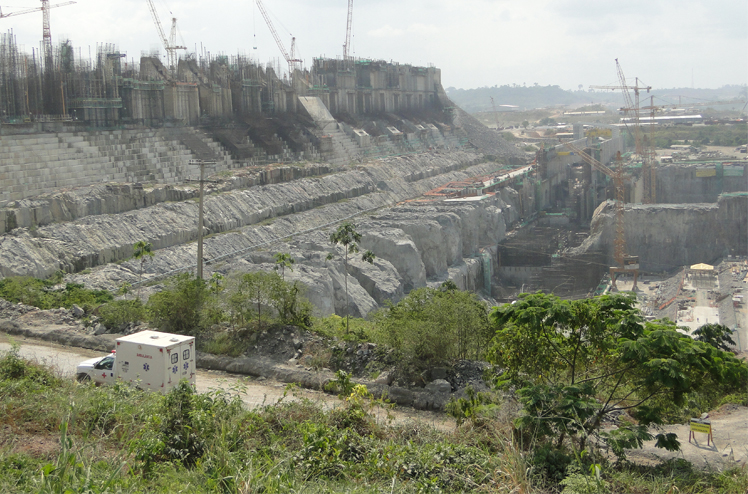Writer: Steve Byrns, 325-653-4576, s-byrns@tamu.edu
COLLEGE STATION – A group of 40 international scientists led by a College of Agriculture and Life Sciences professor says three of the earth’s mightiest rivers are being ravaged in the name of progress.
The findings of Dr. Kirk Winemiller, Regents Professor in the department of wildlife and fisheries sciences and Texas A&M AgriLife Research fisheries scientist in College Station, and his colleagues were released in the scientific journal Science.
The paper, “Hydropower Expansion in the Amazon, Congo and Mekong – a looming threat to global biodiversity,” and the collaborating authors list are available at
http://www.sciencemag.org/lookup/doi/10.1126/science.aac7082.
“The article summarizes the negative impacts of hydroelectric development on the incredible fish diversity and ecosystems of tropical rivers,” Winemiller said. “We wrote the paper to bring global attention to this problem, partly in hopes of stimulating research on tropical rivers, and partly to stimulate better approaches for hydropower development that balance true costs and benefits in the context of cumulative impacts.”
The hope, Winemiller said, is that the exposure afforded by publication in Science will boost dialogue among scientists, policymakers and stakeholders globally and stimulate policy reforms to save rivers from major and permanent ecological ruin.
The Amazon, Congo and Mekong rivers, the three targeted by the study, hold roughly one-third of the world’s freshwater fish species, many of which are found nowhere but their respective river basins, Winemiller said.
The three rivers all have limited hydropower dams in place for creating electricity for their areas’ growing economies, and, until recently, were only exploited to a limited degree due to the previously sparse energy demand, he said.
“Most of the existing dams are relatively small and located in upland tributaries, not on the main rivers,” Winemiller said. “But now, over 450 additional dams are planned for these three rivers with many already under construction. Major dams are usually built where rapids and waterfalls boost the hydropower potential; the same sites where many unique fishes adapted to life in fast water are found.”
Winemiller said the Amazon River has 2,300 known species of fish or 16 percent of the world’s known freshwater fish, with more being discovered each year. The Congo Basin ranks second with 1,000 fish species followed by the Mekong with at least 850 recognized freshwater fish.
Aside from the environmental impact and the potential loss of hundreds of aquatic species as the dams are built, the authors warn of widespread human displacement and negative economic impacts as well.
“The Tonle Sap, a large shallow lake in central Cambodia, is a good example,” he said.
The lake hosts one of the world’s most important inland fisheries. Annual harvests of several million tons of fish are supported largely by species that migrate between the lake and the mainstream Mekong River. The Lower Mekong River supports important inland fisheries, recently valued at $17 billion a year, that directly support some 3 million people in Laos, Thailand, Cambodia and Vietnam.
“The economic, social and environmental benefits and costs of hydropower have been widely discussed, but transparency of the ramifications caused by these structures is limited,” Winemiller said. “For example, Brazil’s Belo Monte hydropower complex, that is nearing completion on the Xingu River, will rank third in the world with installed capacity of 11,233 megawatts, however it also may set a record for biodiversity loss owing to its location.”
“Fish species are not evenly distributed in any of these rivers, and many tributaries contain unique species found nowhere else,” he said. “A major Amazon tributary, the Xingu, provides a good example. Its lower stretch provides habitat for about four dozen fish species found nowhere else on earth. These species support local fisheries that supply the international ornamental fish trade, now threatened by the massive Belo Monte Dam.”
Dams block fish migrations, and all three rivers boast economically important species that are strongly migratory. Winemiller said research conducted in Brazil on fish ladders, which in theory allow fish to travel past dams, has shown them to be highly ineffective and, in many cases, damaging to migratory fish.
“Far too often in developing countries, major hydropower projects are approved and begun before any serious assessments of environmental and socioeconomic impacts have been conducted,” Winemiller said.
“We the authors are advocating for better planning conducted at large spatial scales with the goal of finding balance between tapping hydropower potential and sustaining key natural resources. New and evolving technologies are making such evaluations much more accessible.”
Those who permit and finance hydropower development should require basin-scale analyses that account for cumulative impacts and climate change, the paper notes. Proposed dam sites must be evaluated not only for their economic potential but also for environmental sustainability. Such common-sense approaches to assessment procedures would ensure societal objectives for energy production are met while avoiding the most environmentally damaging projects.
Otherwise, Winemiller said, species extinctions and river basin-wide declines in fisheries and other ecosystems will continue to accompany new hydropower projects in the world’s mega-diverse tropical rivers.

